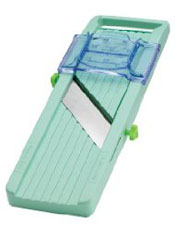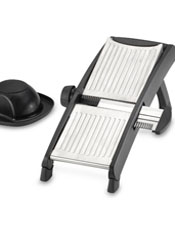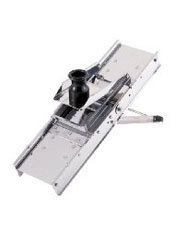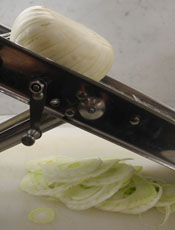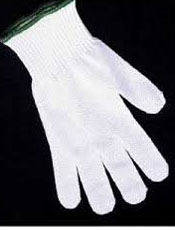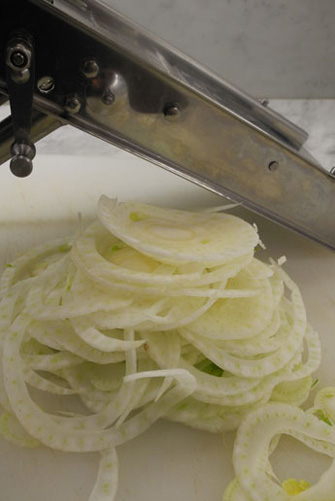Hardware & Software: Mandolines and Slicers
Mandolines. Not mandolins. Not the stringed musical instruments, but mandolines, which are kitchen slicers. I'm always surprised by how few kitchens have one because I consider it an essential. I'd go as far as putting a kitchen slicer on my top 10 list of what I'd buy first if equipping a kitchen.
Slicers come in various sizes, materials, complexity, and price but at its basic, it's a plastic or metal frame that holds an extremely sharp blade that lets you slice things quickly, uniformly, and if need be -- very, very thin.
Why Own a Slicer?
What does a slicer do that a sharp knife held in a steady hand can't accomplish? And isn't this just another gadget taking up space in our small kitchens? And why can't I just use my food processor's slicing blade?
I love my food processor. Having little counter space, for years I kept my Cuisinart in a closet, pulling it out only when I was doing something like pie dough or pesto or butternut squash soup or grinding a big piece of Parmesan. Things that really needed its processing power. One day I thought that if I made room for it on my counter, where it was easy to see and reach, I would use it more often.
But I don't. There's something about its basket and the slicing and shredding blade contraptions that discourage me from using it. It's my go-to tool for chopping and puréeing, but not for slicing.
But my mandoline? I use it all the time. I store it in the front of a cabinet that also holds pots and pans so it's onto my cutting board in seconds. Because so much of cooking is tactile, whatever I'm slicing, I've held in my hand so I can pace the quantity I need and see any bruises or marks I might want to trim, something the processor won't let me do. When the food is sliced it's already right there on my cutting board, ready to work with. And the slicer is into the sink, washed and rinsed, and back into the cabinet in less time than it would take to set up the food processor.
To the question of why not just use a knife: I've got sharp knives and good knife skills, but there are some items that are very difficult to cut both thin and uniform. Like raw fennel for a salad or celery root for rémoulade. Plus there's speed. I can cut slices far faster on a slicer than I can by hand. Since I think the worst of cooking drudgery comes from the cutting, prepping, and mise en place, a slicer can reduce that drudgery and at the same time, produce attractive results. Attractive as in "we eat with our eyes…" by making slices all the same size.
And is it a gadget? Here's my rule: no matter what it is, if a kitchen tool is used regularly, make space for it. If you don't use it, it's a gadget.
Which Slicer To Buy
There are dozens of different brands and models and if it's your first slicer, it can be tricky to choose. They range in price from $10 to $200, from the very simple, to sturdy stainless steel professional models. I would recommend that if you've never cooked with a slicer, begin with a simple one and at the same time, think about how you'll use it.
A basic slicer is a plastic frame that holds a stainless steel or ceramic blade. One hand holds the slicer while the other rubs whatever you're slicing against the blade, which will have been set at a desired thickness. The cut food falls below the blade, either into a bowl or onto a cutting board. After using it, you can wash a slicer in the dishwasher, although a rinse in hot soapy and then clean water is usually all that's needed.
From this point, slicers can get fancy. Some have multiple blades that can be switched out depending on the type of cutting you want to do. Others have a single blade that is adjusts for thickness. Some have stands so that the slicer can be positioned at an angle on a cutting board; others have notches in the frame so that it sits horizontally over a bowl. Still others have a handle, similar to a Microplane grater.
If you select one with a stand, make sure it has non-slip feet. This is essential for safety. Also for safety, choose one that you can store with the blade shielded from vulnerable fingers that might reach for it in a drawer.
Slicer brands include OXO, Kitchen Aid, Kyocera (specialists in ceramic blades), and the highly recommended Benriner. At about six by five inches, some of these are small enough to fit in a kitchen drawer, but others are longer and thus will need to be stored in a cabinet. Prices for simple slicers range from about $10 to $50. A Japanese Benriner costs about $35.
Professional models are more elaborate, bigger, and more costly -- about $150 to $200. These are made from stainless steel and also have a stainless steel blade that can be removed and sharpened by a professional knife sharpener. Professional mandolines are about 18 inches tall and 5 inches wide, have an adjustable stand with little rubber feet to keep it stable, and it's easy to adjust the blade for thinner or thicker slicers. Mandolines also have an adjustment that lets you make crinkle cuts without changing blades, a nice tool for adding a decorative touch when making potato chips or hors d'oeuvres.
Mine is a professional stainless steel model by Bron, made in France, that I bought soon after I finished culinary school. At the time I thought it was a splurge but it's turned out to be an extremely practical purchase, and as I've said, a favorite kitchen tool.
When you get your first slicer, practice with it a bit. Try out the blades by slicing a potato or julienne some carrots so you can get comfortable with how the slicer works.
What To Do With a Slicer
In our home, salads and vegetables are the core of our daily meals and I find that variety helps these dishes stay interesting and appealing. But variety is more than the ingredients. It's also the technique, as the pros call it -- meaning how an item is prepared and presented. So one day it's carrots cut into discs and steamed, another day the carrots are julienned and added raw to a salad with chickpeas and a lemon vinaigrette, and still another time the carrots are puréed. A slicer makes this much easier to do.
The same goes for hors d'oeuvres, where appearance can get as many points as flavor. Presentation counts.
Here are some of the ways I use my mandoline slicer:
- Fennel salad or fennel slices to add to a mixed salad. See our recipe.
- Crispy salads with ingredients like radishes and celery. See our link to a recipe from the great Gabrielle Hamilton.
- Cucumber salad. I simply slice seedless cucumber into paper-thin slices and dress with a mix of Asian flavors. See our a recipe.
- Cut zucchini or small potatoes, such as fingerlings, into little discs to either braise or sauté. See our recipe for how to turn little potatoes into tender and buttery coins.
- Fruit platters and fruit tarts. Use the blade to slice firm fruit like apples or pears into attractive uniformly thin slices.
- Slicing summer cucumbers to make pickles. Having uniform slices will produce better results, plus the slices will look prettier in their jar.
- Plantain or potato chips. Whether deep-fried or baked, very thin and uniform slices will cook more evening plus look better. It's particularly helpful when slicing sweet potatoes, which are harder than white potatoes.
- Citrus slices for summer lemonade, for topping fruit tarts, candied for desserts, or to use as a garnish on a whole poached fish.
- Slicing hard cheese, cutting onions for fried onion rings and when caramelizing a large amount for soup or pissaladiere, and prepping vegetables for a dehydrator.
The one item I don't cut with my mandoline is tomatoes. No matter their size, and whether peeled or not, tomatoes are always just too soft to press against the blade. I get a far better result with a serrated knife. Likewise if a vegetable like zucchini is very ripe and a bit soft, it can turn to mush on the slicer. Better to use a knife.
Own a Slicer? Buy a Glove.
The blades on these slicers are sharp. Extraordinarily sharp. That's key to their functionality. But this makes your fingers very vulnerable. Even if you're willing to waste a lot of food and not cut a potato or a stalk of celery or a fennel bulb down to its ends, you're still at risk of cutting yourself when using one of these slicers.
Many slicers come with a pronged device that is supposed to hold the food and shield your fingers while you slice. But I think these holders are not only useless -- they also make the slicer more dangerous to use. That's because they let you think you're protecting yourself except that the food can easily slip off the prongs and your fingers will take its place.
My advice is to throw the holder away and instead buy a mesh cut resistant glove.
These gloves are made of a steel-like fiber coated in a PVC or Teflon-like material that is almost imperious to cuts. You wear the glove on the hand holding the food item so there's no risk should your fingers graze the blade. The gloves are sold in houseware stores, usually alongside the knives, and cost about $15 to $20. They come in sizes, fit either hand, and you can wash them in hot soapy water or by placing the glove on the upper rack of the dishwasher. These gloves are also great to wear when shucking clams or oysters.
You'll make back the cost of the glove with the food you'll save because now you'll be able to use every bit of that sweet potato or seedless cucumber without any waste -- and without any lost fingertips.
